Long before the days of GPS and satellites, curious and brave seafaring explorers used their knowledge of the ocean and the night sky for guidance. They explored the oceans in Polynesian outrigger canoes, the style of which has sailed the Southern Pacific Ocean for over 5,000 years.
In some places, single wooden-hulled Polynesian outrigger canoes are still in use today.
While a single carved-out tree makes up the hull, what distinguishes Polynesian outrigger canoes is that traditionally, they have only one outrigger. In contrast, Southeast Asia more often had double outriggers. Importantly, double-hulled canoes (catamarans) were also popular amongst the early Polynesian people.
Today, many original style wooden vessels can be found on the waters, but more often we have seen Polynesian outrigger canoes made from modern materials. However, the basic long narrow shape with the addition of only a single outrigger has withstood the test of time.
It is the detailed handwork of the older vessels that I find so intriguing.
Taking a closer look at the construction details of the Polynesian outrigger canoes, the challenge these brave men faced seems multiplied.
The New Zealand Maritime Museum displays replicas of voyaging canoes from Polynesia, Melanesia, and Micronesia.
Larger vessels were used for migration sailing and were often double-hulled canoes. In fact, these are the type of boats that brought the first Polynesian people to New Zealand.
The legend of Kupe
Maori legend tells us that Kupe discovered New Zealand about 1,000 years ago. He sailed to Aotearoa (New Zealand) from Hawaiki, the traditional homeland of the Maori people. Today, no one today knows the exact location of Hawaiki. However, the accepted belief is that it is somewhere in Polynesia.
Where is Polynesia?
Polynesia is an eastern subgroup of Oceania and consists of over 1,000 islands in the Southern Pacific Ocean. It is not as clearly defined as many regions with land borders. In fact, different sources include different countries in Polynesia. The conflict is generally regarding the outliers.
However, regardless of where you draw the physical borders, most will agree that the countries listed just below are culturally Polynesian. A triangle from Hawaii to New Zealand to Easter Island defines this group.
The commonly agreed-upon list of countries of each region:
- Polynesia: American Samoa, Cook Island, Easter Island, French Polynesia, Hawaii, New Zealand, Norfolk Island, Niue, Pitcairn Islands, Rotuma, Samoa, Tokelau, Tonga, Tuvalu, Solomon Islands, and Wallis and Futuna.
- Melanesia: Fiji, New Caledonia, Papua New Guinea, Solomon Islands, and Vanuatu.
- Micronesia: includes the archipelagos of the Caroline Islands, the Gilbert Islands, the Mariana Islands, and the Marshall Islands. There are also independent islands in the region.
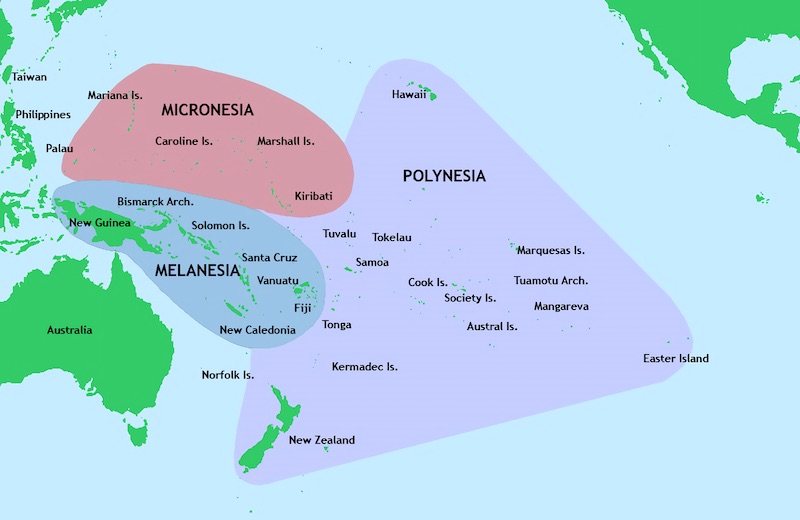
Polynesian outrigger canoes
What we do know is the detailed craftsmanship that went into building Polynesian outrigger canoes is similar throughout the region.
Many replicas of these boats are on display at the Maritime Museum in Auckland, and it’s a great place to get a closer look at some of the details.
At the top of this page is a classic example of an outrigger canoe. The main parts are:
- Hull/canoe – the hull that holds the canoe paddlers, carved from a single log, or stitched together.
- Boom: Rather than a single boom like modern sailing vessels, the sail is lashed to two separate booms to raise the sail.
- Sail: woven from plant materials and sewn together in strips. Pandanus matting is the most common in Polynesia. However, New Zealand used flax.
- Outrigger boom: spars leading out from the hull.
- Outrigger: the smaller lateral supports that float on the water and offer balance.
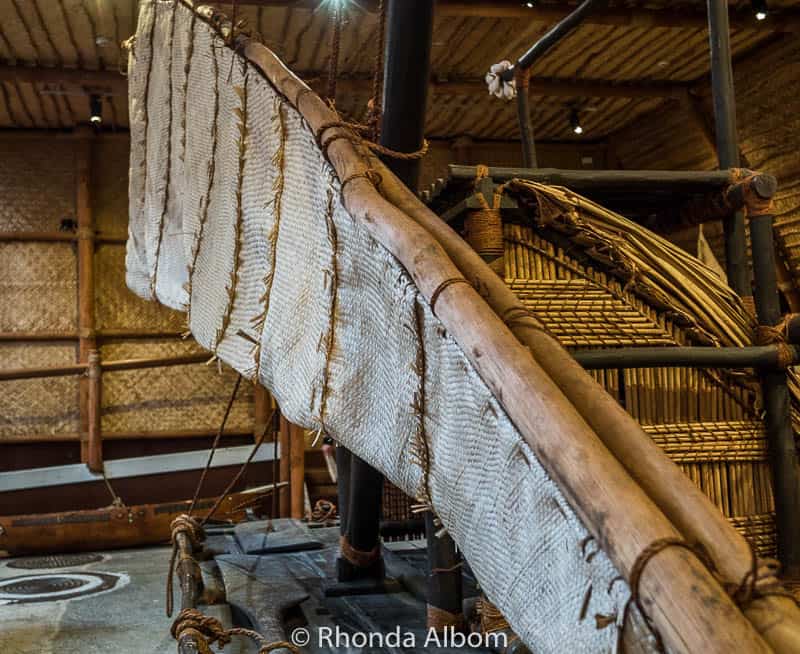
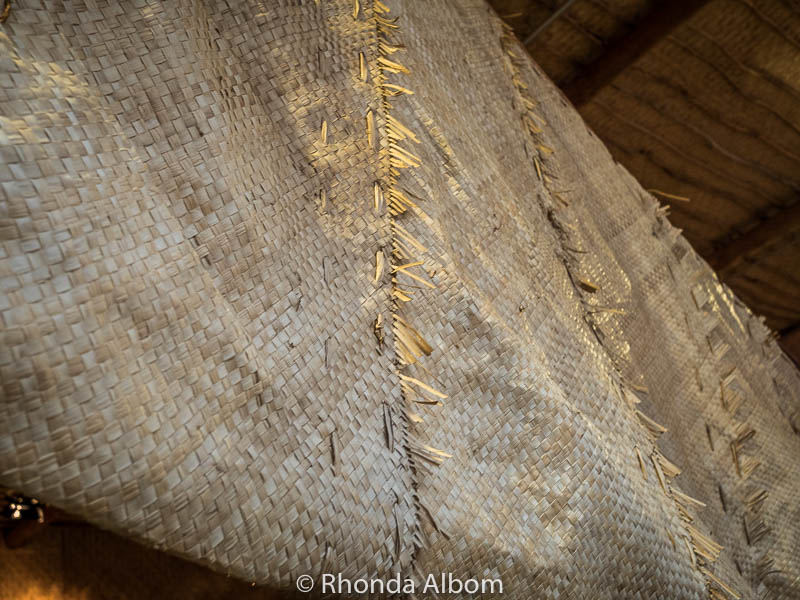
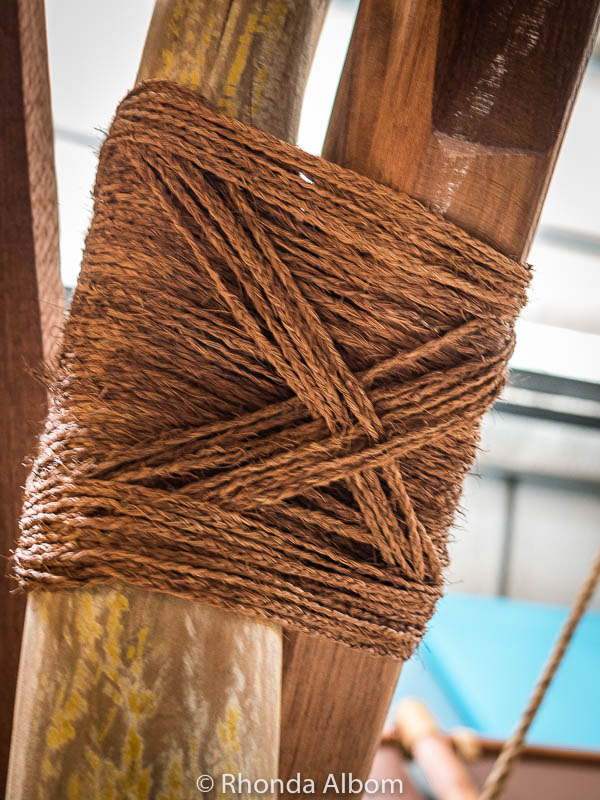
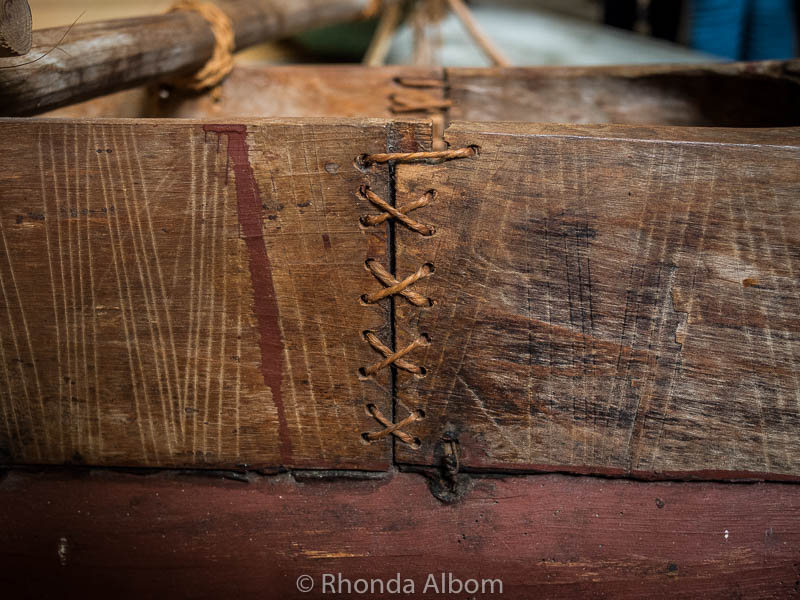
Polynesian outrigger canoes from Tonga
Just below is a Tongan Tongiaki, a double-hulled voyage canoe. The small hut offers the only protection the brave sailors had against the oceans. It’s similar in style to the boats that originally brought the Polynesian Maori to New Zealand. Although, the Maori migration boats are believed to have been about 20 meters in length.
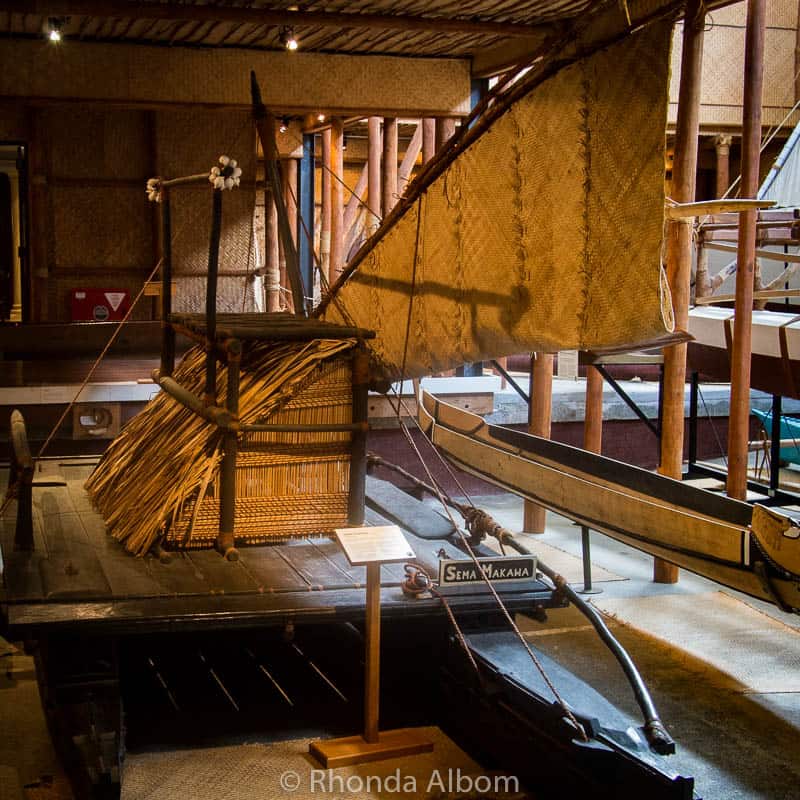
Polynesian outrigger canoes from New Caledonia
This vessel is from the Isle of Pines, an island in the archipelago of New Caledonia (Melanesia). It’s a mix of modern and traditional styles and base materials.
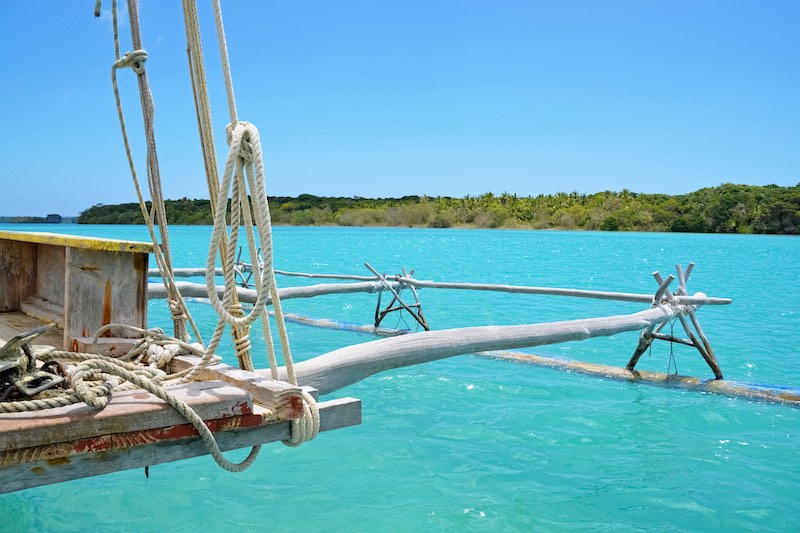
Polynesian outrigger canoes from Kiribati Atolls
Also at the museum is this Polynesian outrigger sailing canoe. In the background of the first shot below is the hull, outrigger boom and part of the sail of Taratai, a 76-foot baurua voyaging canoe from the Kiribati Atolls (Micronesia).
Check out the impressive detail in the lashings on both the smaller canoe and the larger migration vessel.
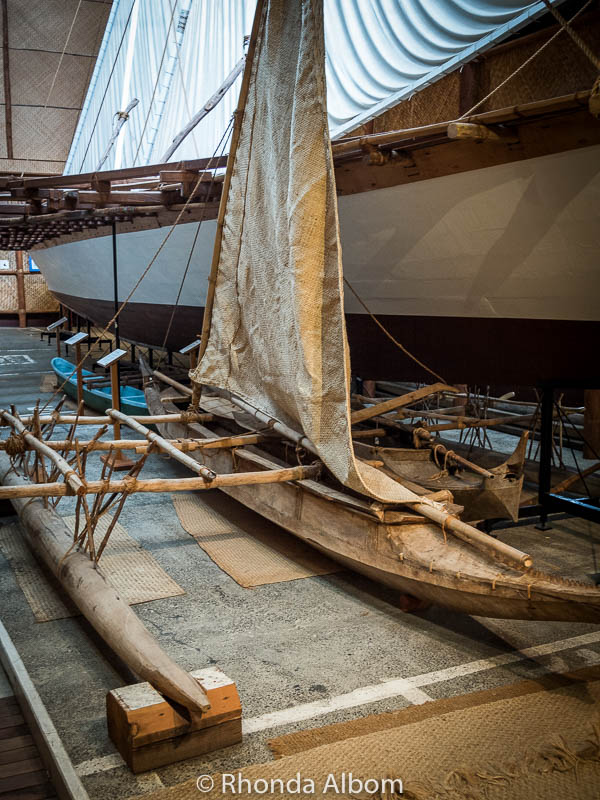
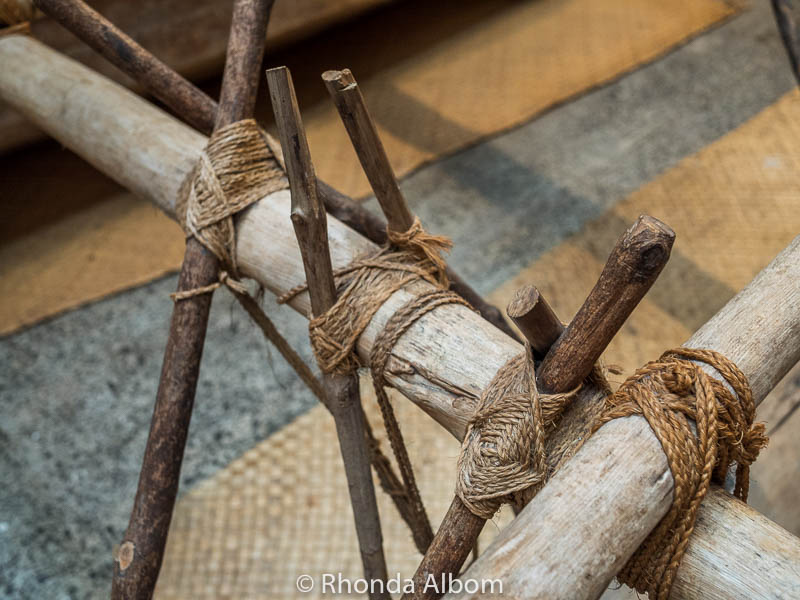
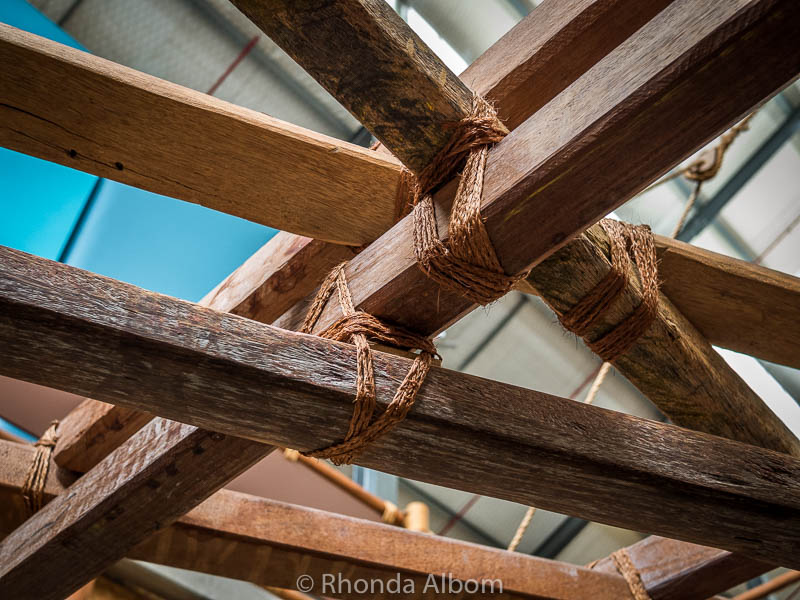
Polynesian outrigger canoes from the Cook Islands
We took all three of these shots on Rarotonga in the Cook Islands. The first two were modern racing vessels. The third is a historic waka outside the Cook Islands Museum and Library.
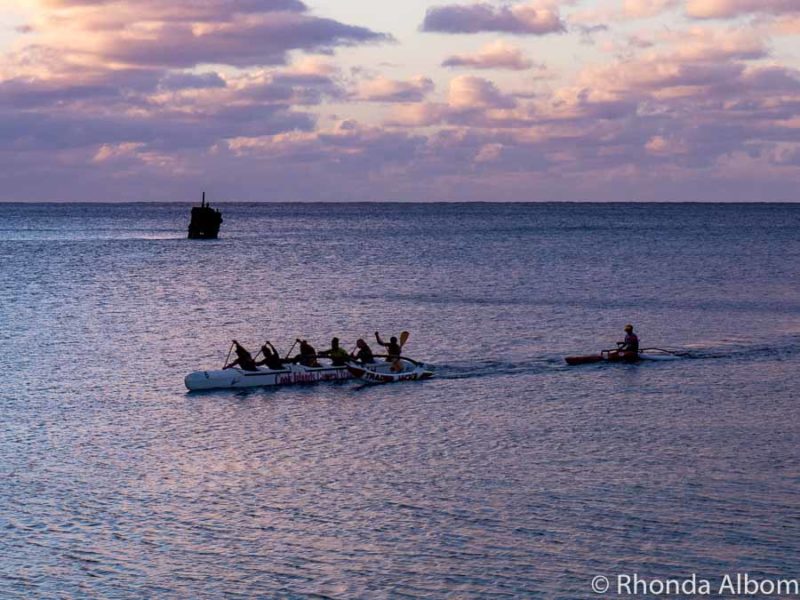
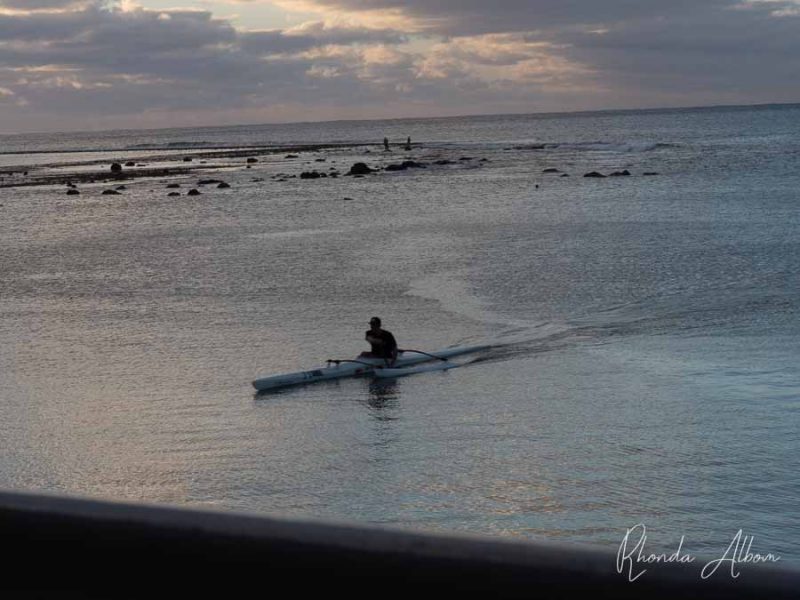
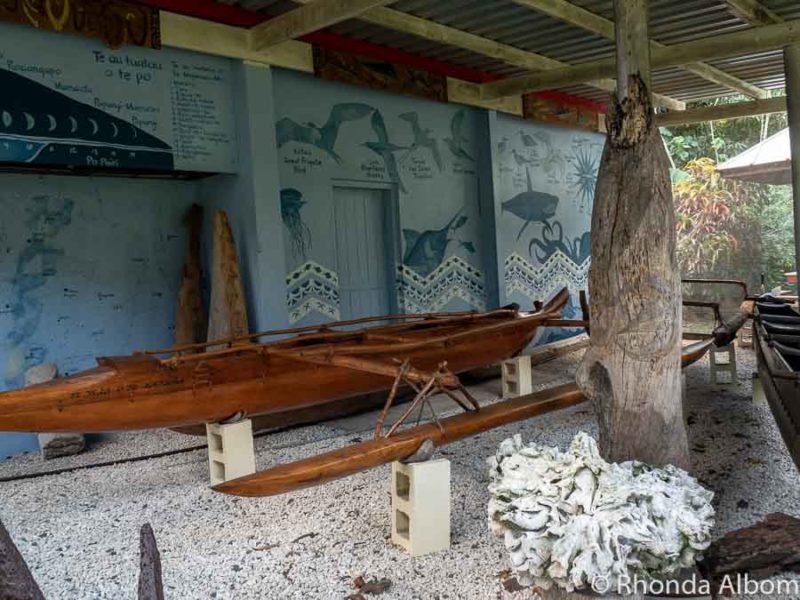
Canoes from French Polynesia
French Polynesia consists of over 100 islands stretching for more than 2,000km. The capital Papeete is located on the island of Tahiti, one of the better known of the islands.
We have visited a few of these islands but captured photos of Polynesian outrigger canoes only in Moorea.
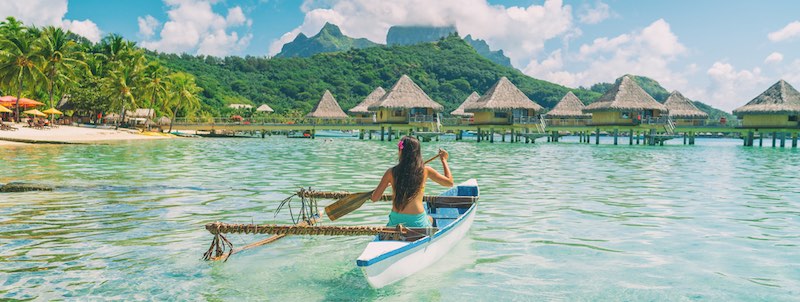
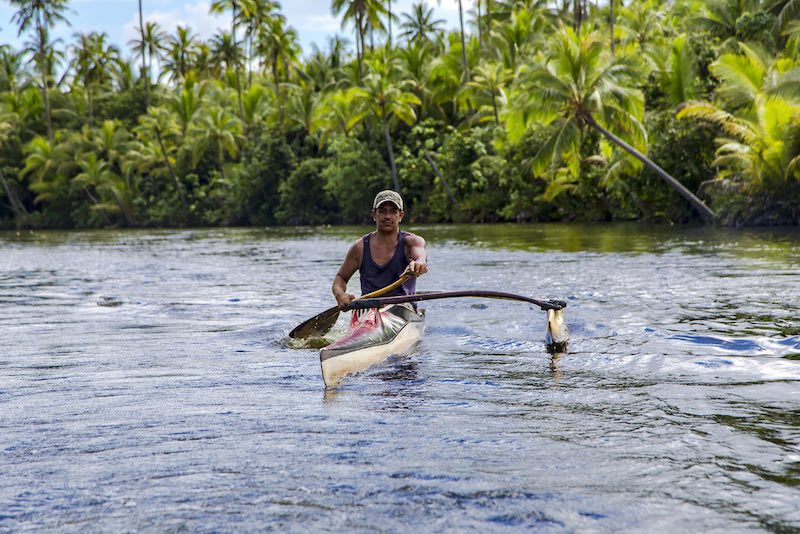
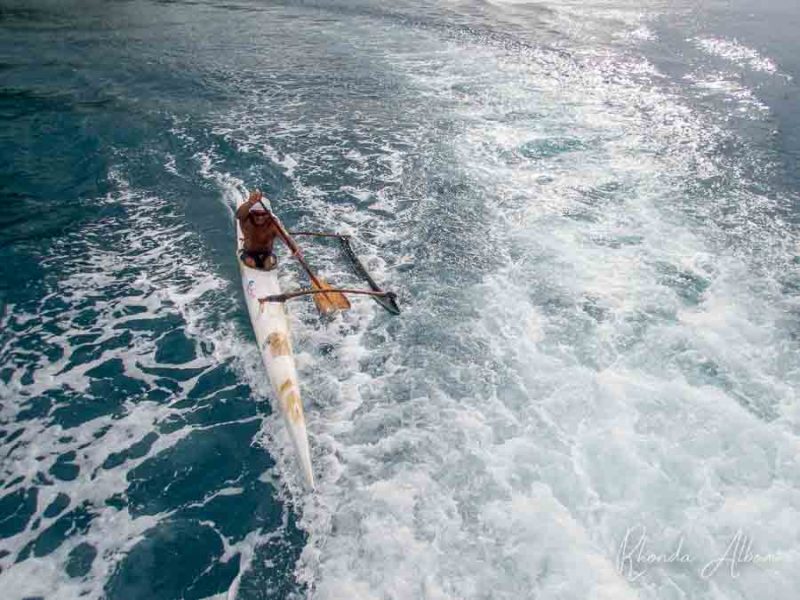
Where to have your own outrigger experience
We are always on the lookout for new experiences that have great reviews from people who have tried them. Here are three that are now on our radar:
- Outrigger Canoe Surfing in Honolulu, Hawaii
An exciting way for the entire family (ages 5+) to catch a wave, this adventure will have you surf three waves as you learn a bit about the history of what was once the official sport of the royal family. Considered so safe, life jackets are not required. Reserve your outrigger canoe surfing experience here. - Outrigger Canoe Snorkel Tour in Maui, Hawaii
Starting from Wailea Beach you will paddle down the south shore to a snorkel spot featuring sea turtles, a variety of fish, and coral that can easily be observed in the pristine waters. You will learn a bit about the culture and celestial navigation from your guide as you paddle to your snorkel spot. Reserve your outrigger canoe snorkel tour here. - Combo Sunset Cruise & Romantic Dinner in Bora Bora, French Polynesia
Not a traditional canoe, as this outrigger vessel is powered, but you will enjoy a two-hour romantic cruise, a glass of champagne, and the sunset along with not more than five other couples. Then you will be taken to the renowned St James Restaurant, where you will have a private romantic dinner at a pre-reserved table. Reserve your cruise and dinner here.
More wooden canoes at the New Zealand Maritime Museum
Documenting New Zealand’s nautical history, the maritime museum in Auckland takes us through the arrival of the nation’s early population. Here are two more images of single-hulled canoes without outriggers.
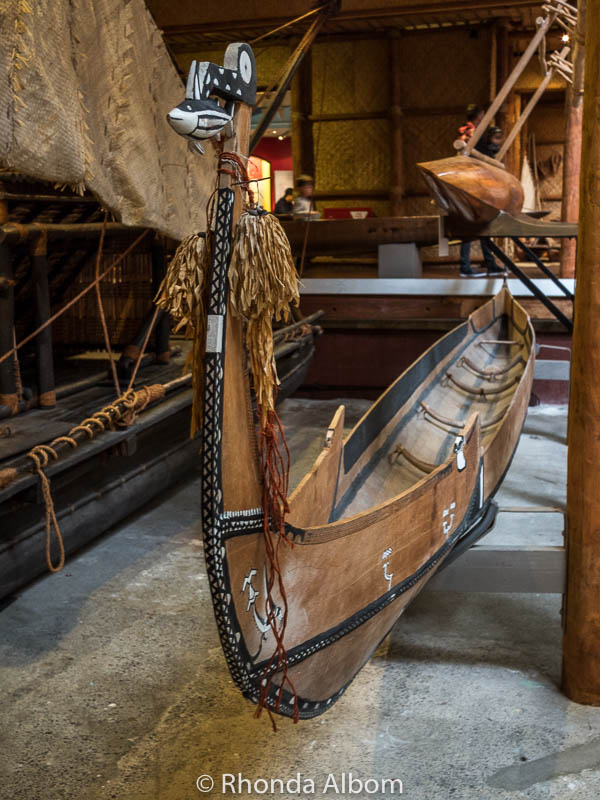
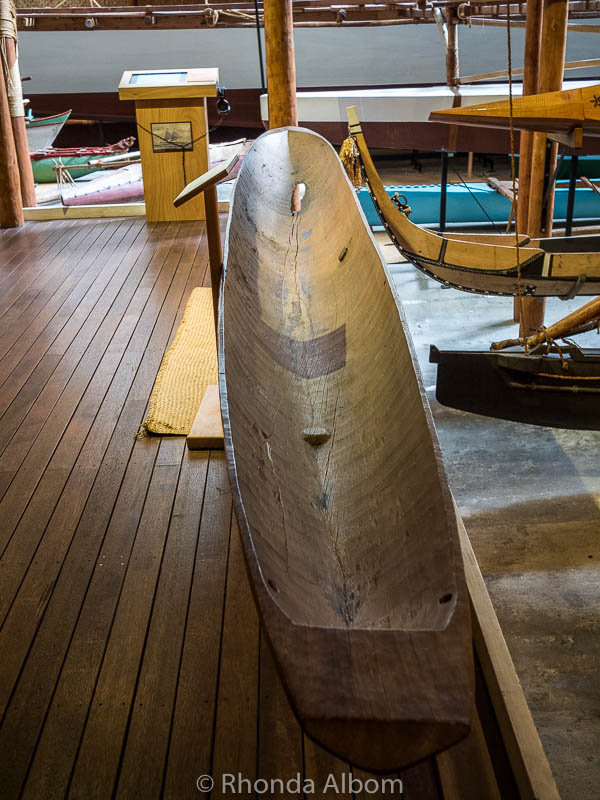
Practical information and tips for visiting the museum in Auckland
- The museum is at Auckland’s Viaduct Harbour at the corner of Quay and Hobson Streets.
- The museum is open nearly every day from 10 am – 5 pm. Also available are optional sailings on the Ted Ashby most days, which offer a chance to get out on the water on a ketch-rigged deck scow. Reserve your museum entry tickets here.
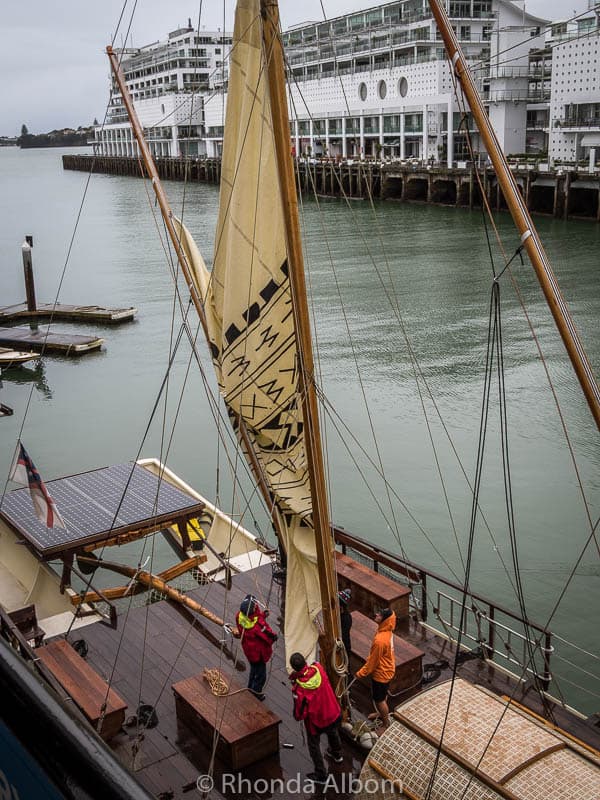
Save for later
If you enjoyed taking a closer look at these Polynesian outrigger canoes, please share this pin on Pinterest:
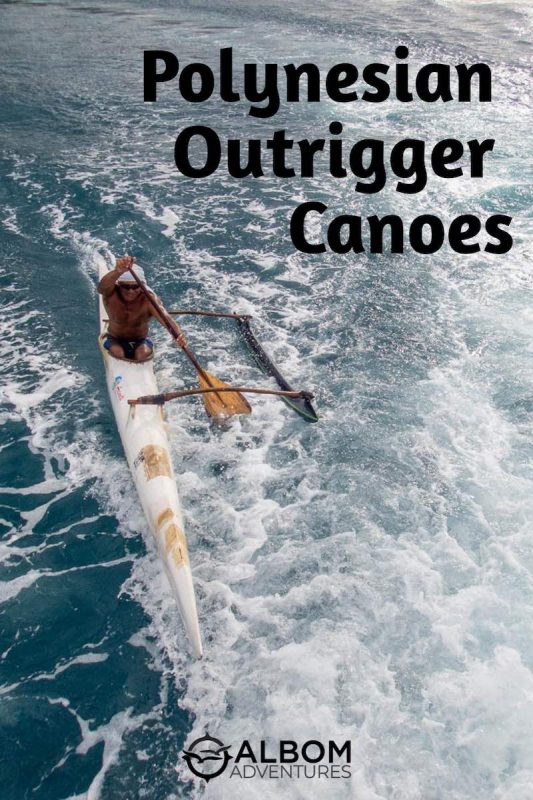

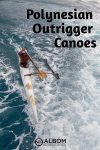
Glenda Cates
Lovely and makes me wish I had a boat to take my son out in. Have a great day.
Rhonda Albom
A boat like one of these, or something a bit more modern?
Rhonda Albom
this is one of my favourite museums because of the details.
Sandy N Vyjay
The word Polynesia itself evokes images of exotic beaches and islands for me. The history of New Zealand and how it was discovered is fascinating. The Maritime museum sounds really interesting, a window to the past. The canoes look ingenious and a silent tribute to the skills of the Maoris of yore.
Rhonda Albom
I agree, when I hear the word I think of exotic destinations, palm trees, and white sand beaches. The maritime museum is the perfect place to learn about the history and how the cultures intermix.
Siddhartha Joshi
Excellent post and really enjoyed looking the history of NZ through it’s original inhabitants! Great pictures of the boat too…gorgeous stuff!
Karla
What an interesting cultural post. I like that they pass down their skills from generation to generation. Thank you for more knowledge.
Rhonda Albom
I am always impressed with skills like this that are passed down for hundreds of years.
Dorene
Very interesting post. The craftsmanship of these outriggers are incredible, the pictures definitely brought me there at the museum to appreciate this.
Rhonda Albom
I hope you get a chance to visit live, it’s a wonderful museum.
Lauren
I can’t even imagine making one of these! What craftsmanship. It’s an amazing art!
Rhonda Albom
I could imagine making one, but I couldn’t image sailing one.
Paige W
How beautiful is that outrigger? I studied anthropology in college, so I know that I would love this museum. It’s so amazing to see how amazingly they used their materials to travel so far. It’s so fascinating!
Rhonda Albom
The museum moves through the ancient history really quickly. The rest focuses mostly on the last 150 years.
Anne
What an unusual museum. It looks pretty fascinating
Rhonda Albom
It takes visitors through New Zealand’s maritime history.
Megan Jerrard
This is quite incredible, I imagine the Polynesian outrigger canoes would have been quite cutting edge technology for their day. It’s quite fascinating to imagine a world of exploration and discovering new lands before we had electronics and motors and all the wonders of knowledge of the modern day. I was really drawn in by the story of Kon Tiki, where Thor Heyerdahl lead an expedition in 1947 across the Pacific Ocean from South America by traditional Polynesian raft. Obviously doesn’t have much to do with New Zealand, but your photos reminded me of that 🙂 Incredible that they crossed oceans in these isn’t it!
Rhonda Albom
The boats are pretty impressive for their age, and the balance must be quite incredible for them to sail so far.
Niels Thomas
Very interesting read, but also my compliments for your excellent photography skills. Really makes the article stand out. 🙂
Rhonda Albom
They are quiet impressive.
Kristy
That’s incredible!!
Rhonda Albom
They are quite impressive.
Paul F. Pietrangelo
This was a very interesting blog Rhonda. The binding was different and amazing. I really liked the canoe. How were these Polynesian outrigger made? Did the Polynesian people have materials to create canoe and outriggers? I would like to go on these Polynesian outriggers and see what it likes in the water. Interesting!
Have a great day Rhonda. See ya.
Cruisin Paul
Rhonda Albom
These boats are 100% hand carved and tied, from natural ingredients like trees and vines. I wouldn’t want to sail on one for very long. I prefer a bit of luxury.
Mindi Hirsch
The Auckland Maritime Museum looks fascinating. In a way, it reminds me of the maritime museum in Palamos (Costa Brava) since both museums provide glimpses into the maritime past.
Rhonda Albom
How small world. We did a long term home exchanged and lived in Palamos. The two museums are somewhat similar, yet quite different as Palamos seemed to focus on fishing and commercial industry.
Shannon
I love reading post like this. I love anything historic really. These canoes are too cool. Hopefully I’ll make it to the museum one day!
Rhonda Albom
Thnaks Shannon, I love learning about things like this, and really focusing in on the details.
Cindy Ladage
I love the story of the canoes and especially the fact that after viewing you can go out and sail in a version of what you just learned about. Awesome!
Rhonda Albom
The modern waka that you can sail on is quite a bit different as it is required to have all the modern safety standards in place.
Patrick Weseman
Wow, what a cool place to visit. Your photos are amazing. I would so love to cool there.
Joyce Lansky
Wonderful post. As much as I want to voyage to New Zealand, I don’t want to go by boat. 🙂
Rhonda Albom
LOL – certainly not one of these boats. There is some modern luxury that would be nice to sail across the oceans.
Alissa Apel
The details are so artistic. I couldn’t imagine going through all the work involved in making one. I strongly appreciate it.
Rhonda Albom
There are still boat makers. When we were in Oman, we saw some of the boat builders who work in teams for five years to hand build a dow boat.
L. Diane Wolfe
So simple and yet so beautiful!
Rhonda Albom
And graceful if you see them sail.
Carol
Fascinating story of ancient migration and cool boats! The child in me always wanted to run away to a tropical island. The practical adult drove to Florida but it’s not really polynesia!
Rhonda Albom
LOL – New Zealand is NOT tropical. We are subtropical. It is winter now, and about 50F right now. Parts of the island even get snow.
indah nuria savitri
Love all the details, Rhonda..such an incredible collections!
Rhonda Albom
I love the details too. Amazing craftsmanship.
Nancy
To my eye, it appears that these would be easy to tip over. I bet they’re sturdier than they look to me, though. Interesting shots!
Rhonda Albom
The distance between the hull and the outrigger determines stability: Closer is less stable. Further is more stable.
Hilary Melton-Butcher
Hi Rhonda – what a stunning and fascinating museum to be able to look round – and yes ‘how did they do it’ … except we know they managed to use the winds to traverse the oceans … Love the craftsmanship … and it’s wonderful we can re-create the things our ancestors used – to enable us to realise a little more about early life … cheers Hilary
Rhonda Albom
They passed the skill down from father to son, using wind, stars, moon, birds and whale migration patterns. They could identify about 150 stars, and used them to find their way. I took a celestial navigation course once, but I was completely lost.
Teresa Kindred
I love these! They look so big!
Rhonda Albom
I guess I should have put some people in them for perspective. Standing there and thinking about people being on them for months at a time, they looked really small.
Carol L McKenna ~ A Shutterbug Explores
Fascinating post and great photos ~ looks like a lovely area to visit ~ ^_^
stevebethere
Nice captures Rhonda interesting and clever 🙂
Have a tanfastical day 🙂
Photo Cache
What a very interesting cultural post. The photos are wonderful too.
Rhonda Albom
It was an interesting way to look at the exhibits I have seen so many times before.
Sandee
Great shots of the craftsmanship. I would love to see these for real.
Have a fabulous day. ☺
Rhonda Albom
I knew you, my boatie friend, would love these images. If you ever come to New Zealand it will be the first place we take you.